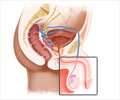Cervical mucus testing may reveal a pregnant woman’s risk of going into labor too early. Permeability and adhesiveness of the mucus can predict the risk.
Highlights:
- Cervical mucus from pregnant women could help predict the risk for preterm birth ahead of time
- Women at high-risk for early labor are susceptible to invasion by potentially harmful bacteria and microbes, leading to infection
- Changes in the permeability of the cervical mucus plays a role in early labor
Cervical Mucus Plays a Key Role in Early Labor
The chemical and mechanical properties of the cervical mucus help it to perform many crucial roles as part of the body’s first line of defense against infection. The research team investigated the chemical and mechanical properties of cervical mucus.A few years ago, Ribbeck and her team conducted a study exploring whether changes in the cervical mucus play a role in preterm births. Nearly 40 percent of the preterm births are caused by infections that occur when the microbes reach the uterus through the cervical plug, which is made of mucus and blocks access to the uterus.
In 2013, Ribbeck found that cervical mucus from pregnant women at high-risk of early labor was mechanically weaker and more elastic compared to women at low-risk.
For the new study, Ribbeck and her team investigated the permeability of the mucus to small particles. Cervical mucus is formed from polymers known as mucins. The composition and arrangement of mucins determine its porosity.
Porosity of the Cervical Mucus
For the study, the research team collected samples from pregnant women at high-risk for early labor and pregnant women at low-risk of early labor.- The low-risk group included pregnant women who had regular check-up around 30 weeks and ended up giving birth after 37 weeks.
- The high-risk group included women who went into labor between 24 and 34 weeks.
The research team conducted a similar test with charged peptide probes, which do not get stuck in the mucus network. Peptide probes were used to find differences in mucus permeability and adhesiveness. These peptide probes are sensitive to the biochemical modifications of the mucus. They found that peptides were able to pass through samples from high-risk women more easily.
The findings suggest that cervical mucus from pregnant women at high-risk for early labor is more susceptible to invasion by harmful microbes, increasing the risk of infection that leads to preterm birth.
Altered mucus loses its ability to retain immune system components such as antibodies or antimicrobial peptides, which help combat infection.
"Mucins display all sorts of immunologically active factors that you may also lose when the adhesive properties change," said Ribbeck. The loss of adhesion may be caused by changes in the molecular structure of the mucins.
Test to Predict the Risk of Preterm Birth
The currently available method for predicting the risk of preterm birth is to measure the length of the cervix. A shortened cervix is associated with a higher risk of early labor. But there are cases where a shortened cervix did not lead to preterm birth.Another test to predict the risk of preterm labor is measuring the levels of fetal fibronectin, a material that glues the fetal membranes to the uterine wall in vaginal secretions. But, this test is not a reliable predictor of preterm birth.
Currently, there is no well-accepted universal test. The pathophysiology of preterm birth is complex and what works to assess one patient may not work for another, said Kathryn Smith-Dupont, MIT postdoc and first author of the study.
Cervical mucus testing could be done early in pregnancy, as part of the routine screen to check whether a woman is at high-risk of preterm birth. This test would determine the risk from infection, but not from other causes of early labor.
"If the mucus is thinner or less adhesive than it naturally is, then we can begin to think about factors to add so that we improve its barrier properties," said Ribbeck.
Based on the findings of the study, Ribbeck hopes to develop new ways to restore the normal function of the mucus.
How to Prevent Preterm Birth
Babies born prematurely experience developmental delays, chronic lung disease, cerebral palsy and blindness.- Regular prenatal check-ups are necessary
- Never skip your prenatal vitamins during pregnancy
- Avoid tobacco, alcohol and second-hand smoke
- Avoid the use of over-the-counter drugs
- Stay as stress-free as possible
Reference:
- K. B. Smith-Dupont, C. E. Wagner, J. Witten, K. Conroy, H. Rudoltz, K. Pagidas, V. Snegovskikh, M. House, K. Ribbeck. Probing the potential of mucus permeability to signify preterm birth risk. Scientific Reports, (2017); 7 (1) DOI: 10.1038/s41598-017-08057-z
- How to Prevent Premature Birth - (http://www.health4mom.org/How-To-Prevent-Premature-Birth)













